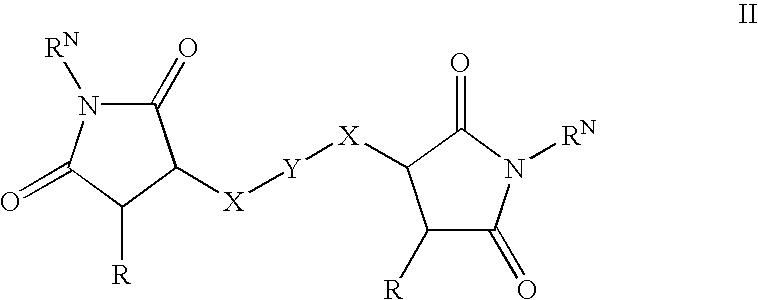Succinimide and maleimide derivatives and their use as topoisomerase II catalytic inhibitors
a technology of topoisomerase and maleimide, which is applied in the direction of biocide, heterocyclic compound active ingredients, organic chemistry, etc., can solve the problems of severe tissue damage, continued worsening for months, and tissue destruction, and achieve the effect of blocking the cytotoxicity of etoposid
- Summary
- Abstract
- Description
- Claims
- Application Information
AI Technical Summary
Benefits of technology
Problems solved by technology
Method used
Image
Examples
example 1
Pharmacological Activity of Selected Compounds
Pharmacological Assays
[0173] The in vitro and in vivo pharmacological assays used to characterise the compounds to be claimed as catalytic inhibitors of the topoisomerase II enzyme are as follows: Clonogenic assay, decatenation assay, alkaline elution, band depletion and plasmid cleavage assay. These assays cover a range of information and shall, as proof of concept of this class of compounds for the use as catalytic inhibitors of topoisomerase II, very briefly be described:
[0174] Clonogenic Assay
[0175] The information derived from the clonogenic assay is cytotoxicity. If a given compound is able to antagonize the cytotoxic effect caused by the interaction of cellular topoisomerase II and classical topoisomerase II poisons, the compound is classified as a catalytic topoisomerase II inhibitor (CI) For medical use, the catalytic inhibitors should only be cytotoxic in relatively high concentrations by themselves.
[0176] A 3-week clonogenic a...
example 2
Synthesis of Sample Compounds
[0192] Compounds of the invention may be prepared by the following synthesis:
[0193] General
[0194] Maleimides may be prepared in a one-step reaction from readily available anhydrides when treated with a HMDS / methanol reagent in a DMF solution at room temperature.
PUM
| Property | Measurement | Unit |
|---|---|---|
| volume | aaaaa | aaaaa |
| pH | aaaaa | aaaaa |
| concentration | aaaaa | aaaaa |
Abstract
Description
Claims
Application Information
 Login to View More
Login to View More - R&D
- Intellectual Property
- Life Sciences
- Materials
- Tech Scout
- Unparalleled Data Quality
- Higher Quality Content
- 60% Fewer Hallucinations
Browse by: Latest US Patents, China's latest patents, Technical Efficacy Thesaurus, Application Domain, Technology Topic, Popular Technical Reports.
© 2025 PatSnap. All rights reserved.Legal|Privacy policy|Modern Slavery Act Transparency Statement|Sitemap|About US| Contact US: help@patsnap.com



